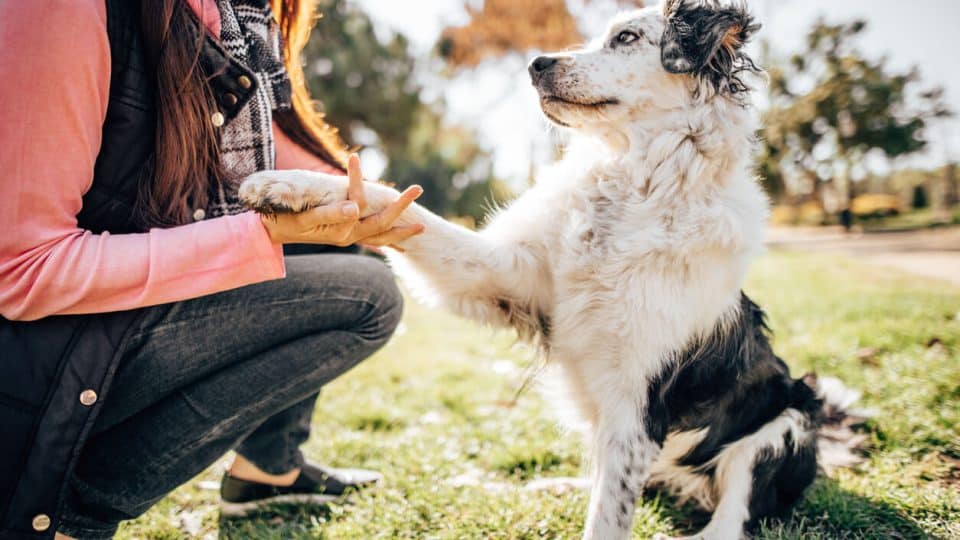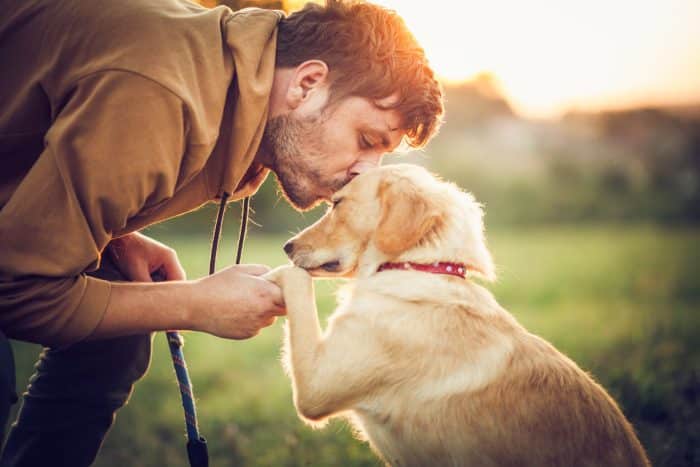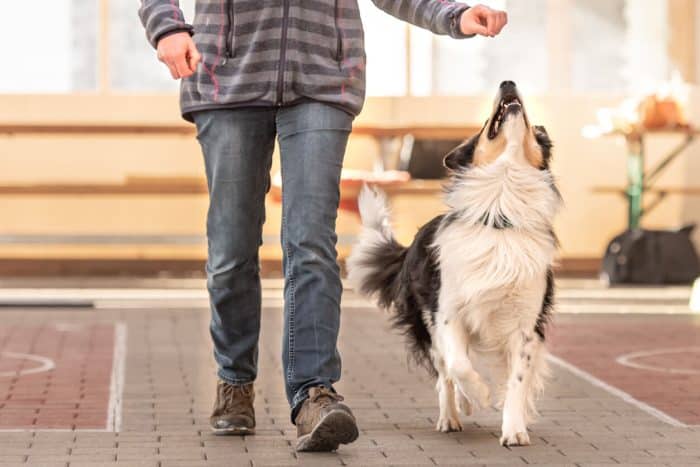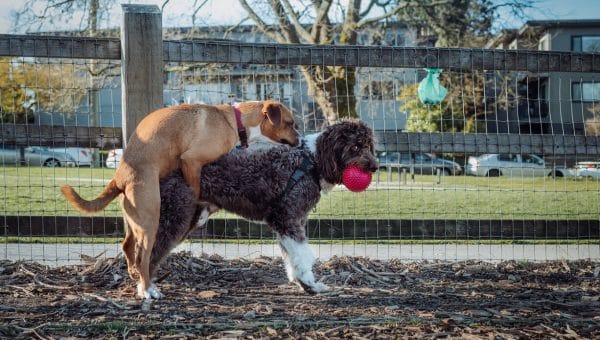- Not a substitute for professional veterinary help.
If you’ve just welcomed a four-legged friend into your family, it may be time to start training! Training doesn’t just prevent your beloved furball from wreaking havoc in your home. The right dog training method can also develop and strengthen your bond and provide your pup with stimulation and enrichment.
There are various training approaches to choose from—but the two most ethical are positive reinforcement and clicker training.
“The right method and style of training will help a dog excel,” says Joe Nutkins, an accredited dog trainer and canine behaviorist. She adds that dogs who don’t enjoy the learning process may become less motivated and, in some cases, more withdrawn and unhappy.
That’s why it’s important to consider your dog’s personality when choosing an approach. “Some dogs require more patience and time to build confidence,” Nutkins says. “Meanwhile, others excel when given new challenges to learn or work through.”
Positive Reinforcement
Positive reinforcement describes a training approach where you reinforce behaviors you want more of by using something rewarding for that individual dog, says Jeanette Muldoon, dog trainer at the Family Dog Club.
Rewards typically come in the form of food or games, but you can use almost anything that reinforces the behavior (and makes your dog more likely to repeat it!).
Positive reinforcement isn’t just one of the most effective dog training methods. It’s also popular since it’s both humane and ethical.
Humane dog training methods center the dog’s emotions, Muldoon says, and consider the reasons behind a specific behavior. “Dogs, like humans, experience emotions,” Muldoon says. “By understanding your dog’s needs, you’re able to help them in situations they’re not sure of and keep them feeling safe.”
You can use positive reinforcement to first manage the situation and then train using rewards, she says. Positive reinforcement also helps build trust between you and your dog and create a more positive training experience, especially if you’re dealing with an anxious dog.
Just keep in mind that it’s important to consider a dog’s behavior when offering rewards.
“For example, a foreign rescue dog may take food from a human, even if they are very worried about the human,” explains Muldoon. “Being fed too many times could lead to the dog showing aggression as they’re not feeling OK in that situation. You have to be careful when dealing with behavior, which isn’t the same as training.”
Clicker Training
This training approach involves using a small, handheld device that creates a “clicking” noise. You press the button to produce a click when your dog does the desired behavior, like sitting when you say “Sit!”
“Initially, you ‘charge the clicker’ by showing your dog that they get something nice after hearing the click, and then you can use it to help progress pretty much all areas of your training,” Nutkins says.
When used as intended, clicker training is a type of positive reinforcement, since the dog develops an association between the clicker and a reward. However, you can also incorporate it with other training approaches.
For instance, you can use clicker training to help your dog build motivation or confidence, says Nutkins. She adds that clicker training is now used in all types of dog training, including gundog, agility, assistance dog work, and more. It can also help pet parents improve timing of praises and rewards.
It’s very adaptable
You don’t necessarily need a clicking device for clicker training.
“Clicker training is also known as marker training. Although the clicker is the most well-known way of marking a skill, you can mark something a dog does in many ways,” Nutkins says. For example, you might say, “Yes!” when your dog does the desired behavior.
Nutkins says some pet parents give a thumbs-up to mark a desired behavior. Others flash a soft-colored light (not a laser) instead of a clicker. You could use a gentle touch, like a pat, as a cue. In other words, you can make clicker training work for dogs who have hearing problems, too!
Clicker training is both positive and humane. It’s also a very clear form of communication, which makes things easier for both you and your dog. What’s more, you can use this method with dogs of all breeds, ages, and abilities.
It does have a few drawbacks, though:
- The noise of a busy dog park can easily drown out the sound of the clicker.
- Overusing this approach may lead to your dog ignoring cues.
- Some easily scared or anxious dogs can be sensitive to sudden noises.
Modeling Training
Ever watched a video to learn how to do something? Modeling training is based on the same principle of learning through observation. While dogs can grasp new behaviors by watching humans do them, they may learn more effectively by watching other dogs engage in activities.
“This is how animals naturally learn,” explains Leigh Siegfried, founder and training director at Opportunity Barks.
Unsurprisingly, you’ll need a well-trained dog to “demonstrate” the desired behaviors. You might call them to heel and tell them to sit, then attempt to get the “trainee” dog to follow suit.
If you don’t have another dog to act as teacher, Siegfried suggests modeling some activities yourself by:
- Encouraging your dog to move with you
- Showing caution near a threshold
- Exploring an obstacle
- Showing them how to go up or down stairs or get into a vehicle
Siegfried says imitation learning comes naturally to many dogs, but other factors—like the environment and their temperament—can play a role in their success.
Experts believe dogs, like humans, may have “mirror neurons” that encourage this type of behavior mimicking. While there’s no firm proof dogs possess these neurons, but if they do, that may explain how and why they can “model” behaviors from other dogs.
Electronic Training
With technology a big part of our everyday lives, it’s no surprise it sometimes appears in dog training. But not all types of tech-based training are ethical.
Electronic shock collars, for instance, use negative reinforcement. They allow pet parents to send a mild shock to a dog who disobeys or performs an action incorrectly.
But these collars can cause fear and pain. They also lead dogs to do specific behaviors because they’re scared of what will happen if they don’t—not because they’ve learned the behaviors are the right ones.
“I haven’t ever used one myself and would choose not to use one,” Muldoon says, adding that she’s worked with dogs who have experienced negative effects from these collars. She says that when punishment is used to suppress behaviors, dogs may eventually show this as aggression.
Pup-friendly electronic training
There are humane ways to involve electronics in training. For example, treat dispensers can provide rewards when a dog performs an action correctly. In fact, one small study found them effective as a way of “training out” excessive barking and jumping among reactive dogs.
“Treat dispensers are great as the dog gets to control the treats by doing what’s required to get one,” says Muldoon. She adds, though, that dogs who can’t work out how to get the treat may become frustrated.
Alpha Dog (Dominance) Training
Alpha dog training is based on the idea that pet parents teach dogs their “place” as the lowest-ranking member in the hierarchy of a family dynamic. It stems from the idea that dogs, like wolves, have a pack with a hierarchical structure.
Basically, any “dominant” dog behaviors require correction by the human caregiver so the human can assert themselves as alpha, according to Renee Rhoades, Head Behavior Consultant at R+Dogs.
However, Rhoades says experts have questioned this training method in recent years since it’s based on incorrect information. “Domesticated dogs do not have a hierarchical pack structure, even when they’re left on their own. They have loose and fluid social structures, not hierarchies with overseeing alphas.”
Pet parents who use this training method typically get a quick response from dogs—but Rhoades says this is often because the dog obeys out of fear, and that the cons of this method far outweigh the positives.
A power struggle between you and your dog can lead to a number of adverse consequences, including:
- Lack of trust
- Low confidence
- Increased anxiety
- Increased barking
- Increased destructive behavior and aggression
- Increased risk of skin and digestive health issues
- Hyperactivity and poor concentration
Because alpha dog training usually involves punishments in some form to correct behaviors, Rhoades says it’s best avoided entirely.
How To Choose A Dog Training Method
There’s no single best training approach for all dogs.
“Every dog is an individual and should be trained as such,” says Emily Birch, a clinical animal behaviorist. For instance, you might find a confident dog responds well to clicker training, while an anxious dog does better with positive reinforcement alone.
She also emphasizes the importance of considering a dog’s history and personality during training. For example, a nervous dog may avoid interactions with a new object or situation—so when starting out, you might find it helpful to use reward-based trainings, like using a treat as a lure.
Know, too, that you can train dogs of any breed or age!
“The old adage you can’t teach an old dog new tricks is far from true,” Birch says. “All dogs are capable of learning at any age. That said, puppies (like young children) are sponges and learn so much, so fast.”
What to avoid when training your dog
Birch explains that training falls into two camps:
- The dog engages in training because they’re excited about the consequences if they perform specific actions.
- The dog engages because they’re scared of the consequences if they don’t.
Needless to say, all pet parents should take the first approach to training. This means focusing on keeping your approach ethical and humane and avoiding punishment.
Negative or punishment-based training approaches can damage your relationship and lead to more unwanted behaviors.
What if the training method doesn’t work?
If it feels like you’re getting nowhere, what next?
Stop and try a different method! It’s never too late to switch, Birch says.
You might even find that blending a couple of training approaches provides better results. For example, many puppy obedience classes use a combination of positive reinforcement and clicker/marker training.
When you’ve tried several training methods and still have no luck, Birch says it’s time to assess your dog on a deeper level.
- Are they in pain? If your dog doesn’t fully engage, consider whether health concerns or age-related issues might be getting in the way. For example, Birch points out that older dogs might have trouble sitting on painful arthritic hips.
- Are they anxious? “Often, dogs who are so worried about life can’t ‘learn’ new things because their need to survive is too high,” Birch explains.
- Are you using the right type of reinforcement? You don’t have to use treats! “Anything, I mean anything, can be a positive reinforcement if your dog perceives it as such. Chasing water, sniffing a scent, playing tug, racing their friends,” Birch says. You can use anything that increases the chances of a behavior happening again as a reinforcer.
Keep in mind, too, that it a helping hand from a dog trainer or behaviorist can make a huge difference. Trainers can help you adapt training methods to make them work for your dog.
“A great training school can be worth its weight in gold,” Birch says. “You learn so much.” She adds that you may want to seek help from a behaviorist if your dog shows aggression, reactivity, or fearfulness.
Don’t be afraid or embarrassed to ask for help. You’re not the first to parent a more challenging pup, and you won’t be the last!








